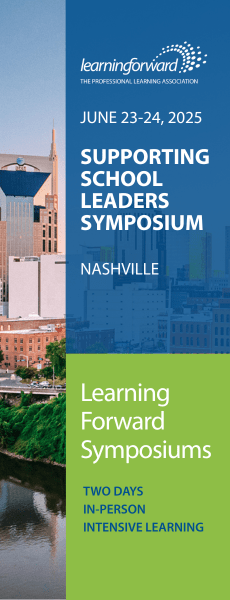The Bottom Line on Excellence
A guide to investing in professional learning that increases educator performance and student results
By Learning Forward
February 2012
Vol. 33 No. 1
Read the remaining content with membership access. Join or log in below to continue.
Sed ut perspiciatis unde omnis iste natus error sit voluptatem accusantium doloremque laudantium, totam rem aperiam, eaque ipsa quae ab illo inventore veritatis et quasi architecto beatae vitae dicta sunt explicabo. Nemo enim ipsam voluptatem quia voluptas sit aspernatur aut odit aut fugit, sed quia consequuntur magni dolores eos qui ratione voluptatem sequi nesciunt. Neque porro quisquam est, qui dolorem ipsum quia dolor sit amet, consectetur, adipisci velit, sed quia non numquam eius modi tempora incidunt ut labore et dolore magnam aliquam quaerat voluptatem.
Federal Sources of Funding for Professional Learning
Many federal agencies, such as the U.S. Department of Education, National Science Foundation, and the National Endowment for the Humanities, offer grant funding to improve educator effectiveness. Included here are several details about federal funding.
— M. René Islas, Director, Center for Results
References
U.S. Department of Education, Office of Communications and Outreach. (2011, September). Guide to U.S. Department of Education programs. Washington, DC: Author. Available at www2.ed.gov/programs/gtep/gtep.pdf.
U.S. Department of Education. (2011, June). A summary of highly qualified teacher data. Washington, DC: Author. Available at www2.ed.gov/programs/teacherqual/resources.html.
| The U.S. Department of Education offers more than 40 multimillion-dollar formula and discretionary grant programs that fund professional learning for Pre-K-12 educators.
• Formula grants go to grantees on the basis of a predetermined formula. State educational agencies usually receive these funds and in turn subgrant them to local educational agencies and schools. These often considered state-administered programs, though the funding is federal. • Discretionary grants are awarded on a competitive basis. |
The two largest federal programs that provide consistent formula funding for states, districts, and schools for professional learning are:
Title I, Part A — Improving the Academic Achievement of the Disadvantaged, and Title II, Part A — Improving Teacher Quality State Grants. • Title I, Part A has provided nearly $14.5 billion per year since 2009 to state and local educational agencies for various activities. Title I, Part A schoolwide and targeted assistance programs stipulate that districts and schools receiving these funds “devote sufficient resources” for professional development. The program also requires that schools that fail to meet adequate yearly progress for two consecutive years must reserve at least 10% of Title I, Part A funds for professional development (U.S. Department of Education, Office of Communications and Outreach, 2011). • Title II, Part A is the most direct source of federal funding for professional development. The program has provided states, districts, and schools $20 billion since 2005 for activities that improve educator quality. The average individual Title II, Part A grant award for 2011 was $42 million, with some grantees receiving up to $268 million. |
The U.S. Department of Education commissions an annual study of how grantees use Title II, Part A funds to improve teacher and leader effectiveness. The 2010-11 study finds:
• 97% of school districts received Title II, Part A funding in 2010-11, with the highest-poverty and largest districts receiving the majority of the funds. • There are more than 10 allowable uses of Title II, Part A funds but professional development and class-size reduction are the two most common uses of the funds. 66% of districts use the funds for professional development with 9% of all districts spending all of their funds for teacher professional development (U.S. Department of Education, 2011). |
RESOURCES:
Professional learning that increases educator effectiveness and results for all students requires prioritizing, monitoring, and coordinating resources for educator learning (Learning Forward, 2011).
References
Barber, M. & Mourshed, M. (2007). How the world’s best-performing school systems come out on top. London: McKinsey.
Chicago Public Education Fund. (2002). Chicago Public Schools Professional Development Project. Chicago: Authors.
Green, M. & McGill, E. (2011). State of the industry, 2011: ASTD’s annual review of workplace learning and development data. Alexandria, VA: ASTD.
Killeen, K., Monk, D., & Plecki, M. (2002, Summer). School district spending on professional development: Insights available from national data (1992-1998). Journal of Education Finance, 28(1), 25-50.
Killion, J. & Colton, T. (2007). Professional development benchmarking consortia study. Houston, TX: APQC & Oxford, OH: NSDC. Available at www.learningforward.org/advancing/apqc-nsdc.pdf.
Learning Forward. (2011). Standards for Professional Learning. Oxford, OH: Author.
Miles, K.H., Odden, A., Fermanich, M., & Archibald, S. (2004, Summer). Inside the black box of school district spending on professional development: Lessons from comparing five urban districts. Journal of Education Finance, 30(1), 1-26.
Odden, A., Archibald, S., Fermanich, M., & Gallagher, A. (2002). A cost framework for professional development. Journal of Education Finance, 28(1), 51-74.
Sawchuk, S. (2010, November 10). Full cost of professional development hidden. Education Week, 30(11), 14-16.
Learning Forward is the only professional association devoted exclusively to those who work in educator professional development. We help our members plan, implement, and measure high-quality professional learning so they can achieve success with their systems, schools, and students.
Recent Issues
BUILDING BRIDGES
December 2024
Students benefit when educators bridge the continuum of professional...
CURRICULUM-BASED PROFESSIONAL LEARNING
October 2024
High-quality curriculum requires skilled educators to put it into...
LEARNING TO PIVOT
August 2024
Sometimes new information and situations call for major change. This issue...
GLOBAL PERSPECTIVES
June 2024
What does professional learning look like around the world? This issue...










